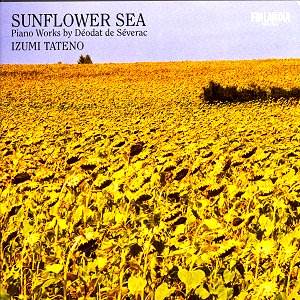Having thoroughly enjoyed Hyperionís collection of Séveracís Songs (CDA66983 released in 1998) with François Le Roux accompanied by Graham Johnson, I was eager to sample this double album of his piano music.
Séverac was a countryman at heart. He spent only about ten years studying in Paris, with Vincent DíIndy and Albéric Magnard, and piano with Isaac Albeniz, among others. He then returned to his beloved home region in the south of France. His home town, on his return, was Céret in Roussillon near the Spanish border. The scents, moods, lights, colour and culture of the region permeated his music. He worked at a leisurely pace, sometimes not writing at all, contenting himself with improvising at the piano for the amusement of his friends. This sense of spontaneity and improvisation permeates this piano music. His approach was similar, in a way, to the French Impressionists although fundamentally he leant more towards Late Romanticism. His piano writing is rich in texture and reminiscent of Albéniz and Ravel.
Much of the music in this compilation is full of easy rustic languor. The unimaginative might think it meanders or that it is ponderous. Certainly Séverac enjoys the view along the way observing lots of detail for us. One should approach listening in the same relaxed frame of mind, let the imagination fly and admire the composerís singularly adept way of catching the character of his rural portraits. Just listen, for instance, to how well he captures the fluctuating patterns and rhythms of the movement of teams of horses, all lucidly caught -- as are all the colourful evocations and atmospheres of all the these pieces -- by Izumi Tateno who clearly loves and empathises completely with Séveracís idiom. Le Chant de Terre is a sound portrait of work in the fields: ploughing and sowing then an interlude for a tale told in the evening followed by a graphic description of a raging hailstorm. En Languédoc is Séveracís picturesque description of his home region with evocations of rushing mountain streams, bells chiming at sunset, a horse galloping through a meadow, a more pensive piece set in a cemetery in spring and a bustling market day scene.
Baigneuses au soleil and Les Naïades et le faune indiscret are scintillating watery evocations with even more nuance and subtlety. Cerdaña has Spanish influence. Séverac deepened the local regional colour by using Pyrenees folksongs. The work has been compared to Albénizís piano suite, Iberia. In the charming En Vacances First Suite, the eight pieces sensitively, and without pretence conjure up the world of childhood. One evokes the comfort of sitting in grandmotherís lap, another has a visit from the girls next door, yet another deals with dressing up and, quite amazingly realistic, is the evocation of an old music box. In the three pieces of En Vacances Suite Two, Séverac pays homage to Chopin and the French Late Baroque style, while the third piece is a light Neo-Baroque canon entitled Les Deux Mousquetaires.
A wonderfully evocative, mostly rustic/pastoral compilation, exquisitely played with every shade and nuance nicely judged. These are slowly evolving, richly detailed musical portraits best savoured when completely relaxed.
Ian Lace


![]() Izumi Tateno (piano)
Izumi Tateno (piano) ![]() FINLANDIA 8573-87181-2
CDs [144:01]
FINLANDIA 8573-87181-2
CDs [144:01]